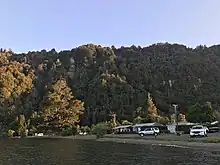Rotoiti, Bay of Plenty
Rotoiti is a settlement on the shore of Lake Rotoiti, in Rotorua Lakes within the Bay of Plenty Region of New Zealand's North Island.
Rotoiti | |
|---|---|
Rural settlement | |
 A playground in Rotoiti on the shore of Lake Rotoiti | |
| Coordinates: 38.053814°S 176.472834°E | |
| Country | New Zealand |
| Region | Bay of Plenty |
| Territorial authority | Rotorua Lakes District |
| Ward | Te Ipu Wai Auraki General Ward |
| Community | Rotorua Lakes Community |
| Electorates | |
| Government | |
| • Territorial authority | Rotorua Lakes Council |
| • Regional council | Bay of Plenty Regional Council |
| Area | |
| • Total | 5.86 km2 (2.26 sq mi) |
| Population (June 2023)[2] | |
| • Total | 530 |
| • Density | 90/km2 (230/sq mi) |
It is located on State Highway 30, northeast of Rotorua.
The Rotoiti Forest is located south of the settlement.
Demographics
Rotoiti is described by Statistics New Zealand as a rural settlement, and covers 5.86 km2 (2.26 sq mi)[1] and had an estimated population of 530 as of June 2023,[2] with a population density of 90 people per km2. Rotoiti is part of the larger Rotoiti-Rotoehu statistical area.[3]
| Year | Pop. | ±% p.a. |
|---|---|---|
| 2006 | 495 | — |
| 2013 | 411 | −2.62% |
| 2018 | 498 | +3.91% |
| Source: [4] | ||
Rotoiti had a population of 498 at the 2018 New Zealand census, an increase of 87 people (21.2%) since the 2013 census, and an increase of 3 people (0.6%) since the 2006 census. There were 147 households, comprising 255 males and 240 females, giving a sex ratio of 1.06 males per female, with 126 people (25.3%) aged under 15 years, 90 (18.1%) aged 15 to 29, 210 (42.2%) aged 30 to 64, and 72 (14.5%) aged 65 or older.
Ethnicities were 33.1% European/Pākehā, 77.1% Māori, 4.2% Pacific peoples, 1.8% Asian, and 1.8% other ethnicities. People may identify with more than one ethnicity.
Although some people chose not to answer the census's question about religious affiliation, 38.0% had no religion, 44.6% were Christian, 7.8% had Māori religious beliefs, 0.6% were Hindu, 0.6% were Buddhist and 1.8% had other religions.
Of those at least 15 years old, 78 (21.0%) people had a bachelor's or higher degree, and 60 (16.1%) people had no formal qualifications. 42 people (11.3%) earned over $70,000 compared to 17.2% nationally. The employment status of those at least 15 was that 159 (42.7%) people were employed full-time, 63 (16.9%) were part-time, and 36 (9.7%) were unemployed.[4]
Marae

The area has seven marae.
Punawhakareia Marae and Uenuku mai Rarotonga meeting house is a meeting place of the Ngāti Pikiao hapū of Ngāti Te Rangiunuora.[5][6]
Ruato Marae or Ngā Pūmanawa Marae and Ngā Pūmanawa e Waru meeting house is a meeting place of Ngāti Rongomai.[5][6]
Tapuaekura a Hatupatu Marae and meeting house is a meeting place of Ngāti Rongomai.[5][6]
Tapuaeharuru Marae and Uruika meeting house is a meeting place of the Ngāti Pikiao hapū of Ngāti Kawiti and Ngāti Tamateatutahi.[5][6]
Taurua Marae and Te Rangiunuora meeting house is a meeting place of the Ngāti Pikiao hapū of Ngāti Te Rangiunuora.[5][6]
Te Waiiti Marae and Hinekura meeting house is a meeting place of Ngāti Rongomai and the Ngāti Pikiao hapū of Ngāti Hinekura.[5][6]
Waikōhatu Marae and Tarāwhai meeting house is a meeting place of the Ngāti Tarāwhai hapū of Ngāti Rangitakaroro.[5][6]
In October 2020, the Government committed $4,525,104 from the Provincial Growth Fund to upgrade Taurua Marae and nine others, creating an estimated 34 jobs. It committed $2,984,246 to upgrade Punawhakareia Marae, Ruato Marae, Tapuaekura a Hatupatu Marae, Tapuaeharuru Marae, Te Waiiti Marae and Te Awhe o te Rangi Marae, creating 20 jobs. Another $499,993 was committed to upgrading Waikōhatu Marae, creating 25 jobs.[7]
Education
Te Kura Kaupapa Māori o Rotoiti is a co-educational state Māori language immersion primary school,[8] with a roll of 43 as of April 2023.[9]
References
- "ArcGIS Web Application". statsnz.maps.arcgis.com. Retrieved 25 December 2022.
- "Subnational population estimates (RC, SA2), by age and sex, at 30 June 1996-2023 (2023 boundaries)". Statistics New Zealand. Retrieved 25 October 2023. (regional councils); "Subnational population estimates (TA, SA2), by age and sex, at 30 June 1996-2023 (2023 boundaries)". Statistics New Zealand. Retrieved 25 October 2023. (territorial authorities); "Subnational population estimates (urban rural), by age and sex, at 30 June 1996-2023 (2023 boundaries)". Statistics New Zealand. Retrieved 25 October 2023. (urban areas)
- 2018 Census place summary: Rotoiti-Rotoehu
- "Statistical area 1 dataset for 2018 Census". Statistics New Zealand. March 2020. 7014676 and 7014678.
- "Te Kāhui Māngai directory". tkm.govt.nz. Te Puni Kōkiri.
- "Māori Maps". maorimaps.com. Te Potiki National Trust.
- "Marae Announcements" (Excel). growregions.govt.nz. Provincial Growth Fund. 9 October 2020.
- "Ministry of Education School Profile". educationcounts.govt.nz. Ministry of Education.
- "Education Review Office Report". ero.govt.nz. Education Review Office.